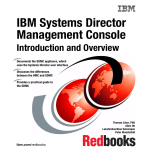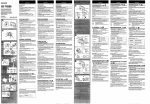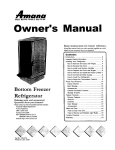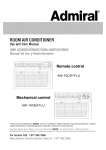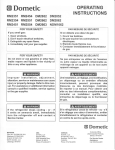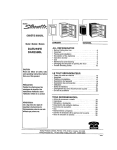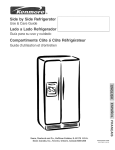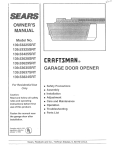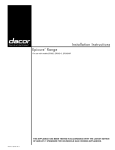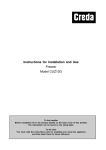Download Amana 12642702 Owner`s manual
Transcript
@@IIW IF'II"WIIIIWIll
IW II_% W@II"
Keep
instructions
for future
reference.
Keep this manua! and your sales receipt together
31ace in case _ arranty sel-vice is required.
Ordering
Questions
parts
about
and accessories?
your
features?
Ptease contact us with yore"model and serial numbe*:
Consumer A_il"s Depal"tment
Amana Appliances
2800 - 220th Tl"ail
Amana, Iowa 52204
Ph# 1(800)843o0304 in USA.
1(866)587-2002 au Canada
Intemet: http:ii www amana.com
Part No. 12642702
Printed in U.S.A. 01/02
in a safe
maintenance
information.
Compmete
registration
cardandpromptly
return.Ifregistration
cardismissing, Amana offers long°term set_'ice
calltheConsumer
AffairsDepartment.
protection for this new refi-igerator.
Warranty
servicemustbeperformed
byanauthorized
servicerAmana
also
recommends
contacting
anauthorized
servicer
if service
is required
afterwarranty Asure Extended Service Plan is
expiresTolocate
anauthorized
servicer,
call1-800-NAT-LSVC
(1-800-628-5782),specially designed to supplement
orcall1{319)622-5511
ifoutside
theUSA Youmayalsocontact
usonthewebat Amaaa's smmg waranty. This plan
www.amana.com.
covers parts, labor, and travel charges_
Call 1(800)528-2682, or contact us at
Whencontacting
Amana,
pleaseprovide
thefollowing
information.
Product
_w'_oamana.com _br more in_brmation.
information
isontheserialplate,located
onceilingoffreshfoodsection.
ModelNumber
Before Calling Service :
TM
'P'Number
Serial Number
Purchase
][f something seems unusual, please
check "Trouble Shooting" section,
which is designed m help you solve
problems be_bre calling service.
Date
Dealer Name
Dealer
Address
Dealer
Phone
This book is intended to show the
variety of t}atures that are available in
the product line. If yore retiigerator
does not have all the options that arc
ShOWn, rnany of these options may be
purchased by contacting the Consumer
Affairs Department. See contact
in*brmation on the cover of your
nlanLtal_
Recognize
Safety
Symbols,
[
Words,
Labels
DANGER--rmmediate
death
about
]
DANGER
]
WARNING
WARNmNG--Hazards or unsafe practices which COULD resuff in severe
personN injury or death
[
]
CAUTION
Instructions
Warning and Important Sat'cry
Instractions
appearing in this manual
are not meant to cover all possible
conditions and situations that may
occur. Common sense, caution, and care
mast be exercised when installing,
maintaining,
or operating refl'igeraor.
Always contact your dealer, distributor,
service agent, or manufi_cmrer about
problems or conditions you do not
undersmn&
hazards which WiLL resuff in severe personN injury or
[
Safety
CAUTION--Hazards
or unsafe practices which COULD resuff in minor personN
injury or product or property damage
I
WARNING
To reduce
refrigerator_
1.
2
3
4
5.
6
7.
risk
of
follow
fire_
electric
these
basic
Read aii instructions before using
refrigerator.
Observe all local codes and
ordinances
Be sure to follow grounding
instructions
Check with a qualified electrician
if you are not sure this appliance
is properly grounded.
DO NOT ground to a gas line.
DO NOT ground to cold water
pipe.
Refrigerator is designed to
operate on a separate 103 to 126
volt, 15 amp, 60 cycle line. DO
NOT modify plug on power cord If
plug does not fit electrical outlet,
have proper outlet installed by a
qualified electrician
sheck_
serious
precautions_
injury_
including
or
8.
DO NOT use a two-prong adapter,
extension cord or power strip.
9. DO NOT remove warning tag from
power cord.
10. DO NOT tamper with refrigerator
controls.
11. DO NOT service or replace any
part of refrigerator unless
specifically recommended in
owner's manual or published
user-repair instructions. DO NOT
attempt service if instructions are
not understood or if they are
beyond personal skill level.
12. Always disconnect refrigerator
from electrical supply before
attempting any service. Disconnect
power cord by grasping the plug,
not the cord.
death
when
the
following;
using
yeur
13. Install refrigerator according to
Installation Instructions. Aii
connections for water, electrical
power, and grounding must compl
with local codes and be made by
licensed personnel
when required.
14 Keep your refrigerator in good
condition. Bumping or dropping
refrigerator can damage unit or
cause unit to malfunction or leak
If damage occurs, have
refrigerator checked by qualified
service technician.
15. Replace worn power cords and!or
loose plugs.
16. Always read and follow
manufacturer's
storage and ideal
environment instructions for items
being stored in refrigerator.
DANGER
To reduce
inc|uding
risk
the
of
injury
or death_
follow
basic
precautions_
fol|owing:
Proper Disposal
of Your Refrigerator
IMPORTANT: Child entrapment and suffocation are not problems of the past. Junked or
abandoned refrigerators are still dangerous-even
if they sit out for "just a few days". If you are
getting rid of your old refrigerator, please follow the instructions below to help prevent accidents.
BEFORE YOU THROWAWAY
YOUR OLD REFRIGERATOR
OR FREEZER:
• Take off the doors.
• Leave the shelves in place so children may not easily climb inside.
Save These
Instructions
3
I
i
nstalhng
Your Refrigerator
o
These instructions
How
were provided
to aid you in tile installation
do I measure
How
an
of your unit. Amana
to Transport
A V," of air space should be provided
for the top and back of tile unit to allow
for proper air circulation. When
installing your unit, measure carefiAly.
Subflooring
or floor coverings (i.e.
carpet, tile, wood floors, rugs) n'my
make your opening smaller than
anticipated.
Use an appliance
f?ont or back.
Your
dolly when moving
fbr improper
installation
Unit
ALWAYS
Now
to
Se|eet
the
t_/ck unit from its side
by wrapping
Secure unit to dolly firn'dy widL straps Thread
overtighten. Overtightening
restraints may
dent or damage outside finish.
cabinet
straps through
Best
NEVER
in blankets
handles
tMPORTAN_ If Unit is to be
installed into a recess where top Of
unit is completely
covered,
Use
dimensions
from floor to top of
binge cap to Verify proper
clearance.
when possible.
the
DO NOT
Location
shield unit
DO NOT install where temperature falls below 55°F (13°C) Malflmction may occur at this
temperature
Make sure floor is level, If floor is not level, shim rear wheels of unit with a piece of plywood
or other shim material
To assure proper door closure,
Doers
and
I
x erify that the unit is leveled with a %" tilt to the back.
Ninges
to get refrigerator
to final location
the
Pu||out
Drawer
Some installations
reqniIe door removal
Now
te Remove
and
Inata||
flora its
or inserting
Observe these points when choosing the final location [br your unit:
DO NOT install refrigerator
near oven, radiator, or other heat source. If not possible,
with cabinet material.
Leve[ }b_lr R@'igerator.
Remove
unit
Protect outside finish of unit during transport
padding between the unit and dolly.
Some clearance may be gained by using
the le\ cling procedure under How to
to
be responsible
Follow these tips when moving the unit to final location:
NEVER transport unit on its side If an upright position is not possible, lay unit on its back.
Allow unit to sit upright for approximately
30 minutes prior to plugging unit in to assure oil
remm to the compressor,
Plugging unit in immediately
may cause damage to internal parts.
opening
to insure
proper fit?
How
cannot
Ifremo\
al of the pullout
drawer
is required,
see later section
entitled
I
WARNING
To avoid
electrical
• Disconnect
shock
power
which
can cause
to refrigerator
before
severe
personal
removing
doors.
I
injury
or death,
Connect
observe
power
only
the following:
after replacing
doors.
I
CAUTION
To avoid
damage
to wals
and flooring,
protect
soft vinyl
or other
flooring
with cardboard,
rugs, or other
protective
material.
==,,,
,o, ,÷o], JA.
c,o,,,>io=cyo.
toe ffrilIe
bracket
and
botton_
cover(s)°
freezer
rerr,
Open freezer door as wide as
possible.
Depending on the model of
your unit, you may have one
or two bracket covers.
door
in place
cc=terhi. .e
with
a54,"he=
=,tdri e,.
ow,ee=erdoo
' Remove
top hing*e cover by
removing_ Phillips
screw.
Retain screw and cover for
replacement.
Remove
bottom
hinge
or stabilizing*
&'iven
bracket
with
3in, _ hex
head
* Lift out bottom hinge pin (some
models).
*
Retain hinge
later use.
pin and
screws
for
__
_ q
I h
i !
II
nstallmg
i
How
to
Reverse
the
Transfer
cabinet
plugs
to opposite
anti
side
Refrigerator
IMPORTAN_
When working directly on doors, place doOrS
on a nonabrasive surface protected by towels or rugs to
avoid damage to door finish.
Doors
rform
listed inand
NOW
to
move aZ/steps
the Doors
Hinges.
screws
Your
o
1J
Transfer
cabinet
of cabineto
door
stops
from
bottom
edffe
of _'esh
and _eezer
door
to
food
opposite
edffe.
side
of door
Use a Phillips screwdriver
installation.
Remove cabinet plugs with flat
Made screwdriver tip wrapped
in masking tape.
Remove center mullion screws
for removal and
with Sl_" hex head driver.
For swing doors only
Remove bottom mullion screws
with si8" hex head driver.
roceed
oors
to
Now
Insta||
and
Nemove
door
1//44_ hCX
_lce
with
17U[
hex
screp/s
out
and
to
Rep|ace
P|inge$
to
mount
the
)
doers.
)
Nand|es
tnstaH#_g
Fresh
Food
Front-Mounted
Handles
If installing handles tbr the first time, the flesh £)od handles can be
located within the t'resh fbod section. The handle trim will be located
in the literature pack.
Refrlove
to MOW
Removing
Fresh
Food Front-Mounted
Handles
Remo\ ing handles may be necessary when transporting unit through
tight spaces, or when rex ersing the door
_,
and/c
_ron_
driver:
].L
]
If reversing door, remove door plugs
B_m
- s<
by
removinff
top boodle
screw.
,Retain
trim and screw for later
replacemenL
"_
/l[
/_'
_"
in screw holes.
I2
Aligm
oo
haodle
door
_,ce
with screw
holes
a.d
sec,,re
doo__"om
Locate
handle
trim/17
pack
and install
over
botton_
with
step
of haodlL5
holes
2
L
_}
]
\ /
Iitetvtmre
top and
(,_ Re,,,o_"tworemaio,%;*
ha.d_'_- ,_--"]
screwsaod removeha_d!e.
" [
]
as i[]ustrated
Secure top handle trim with remaining
screw removed in step 1
Snap bottom trim over bottom portion of
handle
installing
Freezer
Handtee
[finstalling handles tbr the first time, the fl'eezer handles can be
located within the fl'eezer section.
top edge of door and insert into screw hobs.
"
Retainscrewsforiaterrepiacement
_
t
Removing
Freezer
Handles
Remo\'ing
handles may be necessary _hen
tight spaces, or when reversing the door,
transporting
t;nit through
J
nstallmg
i
o
How
to
Your Refrigerator
Insta||
and
Remove
Hand|es
_,,,/,_,,_+
Installing
Fresh Food Side_Meunted
Handles
If installing hal_dles for the first time, the flesh food handles
can be located on the back of the refrigerator,
Removing Fresh Food Side-Mounted
Handles
Removi_g hanctles may be necessa7 when transporting unit
through tight spaces, or when reversing the door.
inataHing
Freezer Handles
Ifi_stallii_g hai_dIes fi)_ the fi_*stdin< the fleeze_ ha_dles car_
be Ideated (:mthe back of the ret_igerator.
Removing Freezer
Handles
Remevi_g ha_dIes may be i_ecessary _ her_ tm_sporti_-_grefit
th_ough tight spaces.
T-15 Torx _'* screws
from edg*e of doon
nsgaI1 handle
by t2tstening
I
*
tee
r-isror,+"',crew,
+o.',t%"._-'..
I
removed
with
Torx®is a registered trademark of Textron Inc.
installing
and Removing
Stainless
Steel Front _Moun_ed
Handles
To avoid risk of serious personal injury from sharp edges, do not remov
front-mounted stainless steel handles from unit.
H_w
te
Rep|aee
the
@ Insert bottom hir_#e p_
#o,.e.,ode+_.
*
Doors
a_d
I _
Hinges
/
p{<o v
Locate bottom hinge hole closest _%___._
to outside edge of cabinet, and
_-.l
insert bottom hinge pin. Replace ""_----.1
any door sh_ms,_fpresent.
'_
4P/ace
center
M;ng*e skle
of re&ig*erator
door
on
hing_e pin.
I "1
'_m'%®ht"
tg*hte_ do_
I
++_.e_+,h%,."he_
head
d,+er _...+/_
top
"<._!
i
How
to Remove
and
Instal!
the
_,
nstalhng
Your Refrigerator
o
Pu|lout
o
Drawer
WARNING
[
To avoid electrical shock which can cause severe personal injury or death, disconnect power to refrigerator before
removing doors. After replacing doors, connect power.
,a CAur,ON
I
To avoid possible injury, product, or property damage, you will need two people to perform the following instructions.
¢-
With d:awerpul/ed out to
,_
\\
fullextension, insert/owet_jk_
_4
Lift
t°p °f d°°:
t°
unhook
door supports
fro,',,
:aU system. Lift
_]_ _
basket
by aHg*ni.g,* tabs
on both side of lower
I"
baskct
__m
]_
_¢-
!
wit_
notches
Z\
', .
in
t,n:t.
M.k.
sttr.
th.t_tI_L]_
-
nstallmg
How
Your Refrigerator
to Connect
the
Water
$upp|y
WARNING
To reduce
the risk of injury or death_
follow
basic
I
precautians_
including
the fallowing:
Read all instructionsbefore installing device.
DO NOT attempt installation if instructions are not understood or if they are beyond personal skill level.
Obsewe all local codes and ordinances.
DO NOT service device unless specifically recommended in owner's manual or published user-repair
instructions.
Disconnect power to unit prior to installing device.
I
CAUTION
To avoid
following:
property
damage
er possible
injury_ follow
basic precautions_
including
the
Consult a plumber to connect copper tubing to household plumbing to assure compliance with local codes and
ordinances.
Confirm water pressure to water valve is between 20 and 100 pounds per square inch. If water filter is installed,
water pressure to water valve must be a minimum of 35 pounds per square inch.
DO NOT use a self-piercing,
or a/_,, saddle valve! Both reduce water flow, become clogged with time, and
may cause leaks if repair is attempted.
Tighten nuts by hand to prevent cross threading. Finish tightening nuts with pliers and wrenches. Do not
overtighten.
Wait 24 hours before placing unit into final position to check and correct any water leaks.
M_ltedals ZVceded
* V4" outer diameter
flexible copper tubing
• Adjustable wrench
• _¼"hex nut driver
• Shut-off valve (requires a _14" hole
to be drilled into water supply
before valve attachment)
NOTE: Add 8: lo tubing length needed to reach water
supply for creation of service loop.
SIMe
brass
screw
aut
out
into
over
in[et
sic'eve
and
porto
iMPORTANT; DO RIOT Overtighten.
Cross threading may occur,
F
PuN on tubin#
coanection
Coaaect
is
to confinz_
secure.
tubing* to frame
with
water tubing* clamp (F) aad
on water supp_v. Check
fat
leaks and correct_ # present.
_ U
water s,
connection
Co!.rec,
:ea
i:
5ce:s forr
Monitor
turn
24 bogaw.
2
-_
nstalling
Your Refrigerator
How to Level Your Refrigerator
If your refi'igerator requires an ice maker water supply connection,
section before leveling your refrigerator.
I
proceed
to How
to connect
the
water
supp|y
A CAUT,ON
I
To protect personN property or unit from damage, observe the following:
* Protect soft vinyUor other flooring with cardboard, rugs, or other protective matefiN
* Do not use power tooUs when performing UeveUing)rocedure
M_redalsNecded
* sis" hex head driver
* Level
%
Using
a level,
refdgerator
h@her
Z
mM_e
is
tl, an
#'ont
sure
_ " (dram)
back
of
'_
of
or ½ bubble
[
re#_emto,:
Reph, ce toe grille and br_,c'kct coverCs).
See markings
on inside
[
of toe griIIe to
[,sure
proper
pl_,cement.
I
Snap bottom portion into place first. Press
[
down on top part of grille until top portion snaps
[rout
of re[r[g*erato_
*
Make sure refrigerator cabinet is level
from side to side by adjusting left and
right roller adjustment screws
_
,
Turn stabilizing leg clockwise until firmly against
floor.
the above listed steps; turn roller adjustment
screws (A) 2 to 3 times ceunterc!0ckwise, so
that full weight of unit rests on stabilizing legs.
Hew
to Adjust
1:he Temperature
Contre|s
This refrigerator is designed to operate at a household temperature of 55 ° to 110°F (13 ° to 43 ° C). For initial temperature
setting, follow all five steps listed below. If doing a simple temperature modification for an operational unit, only steps 3
through 5 are required.
(i
[
Locate
:,:dg_er_tor
cootro/s
compartment
andb'eeze:
at the
controls
top
o:b'esh
food
at top Of #'eezer
section.
)
Seth
How
do I perform
a temperature
test?
MateHagneeded
_ontrcl is set to Off
*
*
2thermometers
measuring-5
m 50°F (-2i ° to !0°C)
2 drinking glasses
°
For Freezer
* Place thermometer
in glass of
vegetable oil in middle of fieezer
and continue with step 3 of
YempeJ'atm'e Adjztsn:_em section.
to 8 hours for adjustments to take effect.
IMPORTANT: Always start
temperature adjustments with
freezer section,
:
*
Turn control to next highest number if too warm
Turn control to next lowest number if too cold.
Allow 5 to 8 hours for adiustments to take effect.
_
\___
|
|
For RefrQerator
* Place them_ometer in glass of
water in middle of unit and
continue with step 3 of
Yempe_'am*'e A@tstmem section.
Fresh
Food
Features
|nterior
Shelves
Deer
$terage
I
CAUTION
To avoid personal injury or property damage, observe the
following
• Confirm shelf is secure before placing items on shelf
• Handle tempered glass shelves carefully Shelves may
break suddenly if nicked, scratched, or exposed to
sudden temperature change.
door. It can be moved to severn
different locations to accommodate
storage needs.
To remove, open dairy door, pull upward and tilt out
To install, reverse above procedure
To remove shelves, unhook
shelf from rear ladder assembly
and pull out.
,_,
_,_'_ll'"-._
"_1!.
Door
Toosta,
she,yes,
osert
she,f
hooksI1 1
•
Spilisaver
TM
some
models
Spillsaver TM stationary shelves
hold simple spills for easier
cleaning
some
TM
EasyGiide
_-_--_Y
1[_
_
[Ii
[_
Netainer
Door retainers remove for easy
cleaning.
To remove, slide retainer
up and puii straight out.
To install, reverse above
procedure
TM
modeJs
Spillsaver TM EasyGlide TM
shelves feature the convenience
of easy cleaning with a pullout
design to reach items in the
back. For ease of cleaning,
glass shelf may be removed by pulling to full
extension and lifting out of frame
Accessories
Grip
She|f
Exten$i@n$
some
Pad$
some
mode]s
The Grip Pads prevents objects from
sliding in the door bucket Grip Pads are
removable and are top-rack dishwasher safe
for easy cleaning
To remove shelf and frame, see instructions
SpillsaveU M stationary shelves
Rear
straight out.
To install, reverse above procedure.
Door
To remove shelves, lift up and out
To install shelves, reverse above
procedure
Spi|lsaver
Buckets
Door buckets adjust to meet individual storage
needs.
• To remove, slide bucket up and pull
L_'_'_ IJ
for
Wine TrivetlCan
Rack
some models
model_"
Rear shelf extensions help prevent articles from falling
off the back of the shelf.
To remove and install shelf extension:
straight up from rear of shelf
To install, insert posts of the
shelf extension into holes in the
shelf frame
Pantry
Divider
some
models
The pantry divider is used to
organize the Chef's Pantry TM
into sections, and features a
collapsable joint on the front
edge to ensure a snug fit.
remove pantry. If removal is
To remove and replace
not possible, pul! drawer open
divider:
to its fullest extension.
To remove, unhook divider from
rear wall of pantry, and pull out.
To install, hook back of
divider over rear wall of
pantry and press down until front joint snaps into place.
i0
Fresh
C|imate-Contro||ed
Food
Features
Drawers
F====_
HUl_lJl_l_=_on_roHe_
Drtsper
Drawers
The crisper drawer keeps produce fresh longer by providing an environment with adjustable humidity.
/t_
The crisper controUs reguUate the amount of humidity in the crisper drawer. Use the low
setting for produce with outer skins. Use the high setting for bafy produce.
Controls
Temperatare-CeatreRea
Drawer
(2#el9 [Sm t_ +_+++
The Chef's Pantry TM system provides a drawer with a variable temperature control that keeps
the compartment up to 5°F (30C) colder than refrigerator temperature. This drawer can be
used for large party trays, dell items, or beverages.
Controm
The Chef's Pantry TM control regulates the air temperature in the drawer. Set control level to cold to
provide normal refrigerator temperature. Use the coldest setting for meats or other dell items
Refrigerator control may need to be adjusted.
$terage
What if I can+t open my door
Drawers
wide
Snack
Drawer
This drawer can be used for storage of food items
or extra produce,
Beverage
Organiz÷r
enough
to remove
the
drawers?
TM
some
furthest from hinge
side of cabinet
Remove drawer
Remove glass as
previously instructed
models
The Beverage Organizer TMslides out
from underneath the SpilBaver TM stationary
shelf. The Beverage Organizer r_ holds up
to twelve 12-ounce beverage cans.
Lift center divider from frame. Slide
existing drawer away from hinge side of
cabinet and remove
What
can
I do to prolong
the
life of my produce?
To remove and install drawers:
+ To remove drawer, pull drawer
out to full extension. Tilt up front
of drawer and pull straight out.
+
Please observe the following rules when
storing produce in humidly-controlled
crisper
drawers
To remove and install gmass and frame:
Remove drawers as instructed above.
•
+
DO NOT wash produce be+bre placing in
crispers+ Any additional moisture added to
the drawers may cause produce to
prematurely
spoil
+
DO NOT line crispers with paper towels+
Towels will retain moisture+
To install, insert drawer into
frame rails and push back into
place.
Place hand beneath frame to push up
glass from underneath. Lift glass out.
+ Follow control instructions carel:ully. Not
setting controls correctly may damage
produce+
Lift frame from refrigerator
See chart below for assistance with controls:
liner rails.
To install, repeat above instructions
reverse order.
in
LOW
° cauliflo_xer
° zucchini
+ apples
* corn
+ grapes
* cucumbers
+ oranges
HIGH
ii
+ lettuce
+ asparagms
+ spinach
+ cabbage
+ celery
+ broccoli
+ fresh sprouts
+ fresh herbs
Freezer
Primary
Features
I
Features
CAUTION
I
To avoid property damage, observe the following:
• Do not force ice maker arm down or up.
• Do not place or store anything in ice storage bin.
D_'awe_'s
Wire
Basket
To remove and install basket:
•
with water and begins operating.
AHow approximateUy 24 hours after installation
•
receive first harvest of ice.
Discard ice created within first 12 hours of operation
To remove basket, pull
out to full extension. Tilt up fro
of basket and pull straight out
to
To install, insert basket into refrigerator liner rails and
push back into place
to verify system is flushed of impurities.
Operating hstructions
• Confirm ice bin is in pUace and ice maker arm is
i
•
•
/
Drawer
down.
o fills
etween 0° to 2°F (-18 ° to -17 o° C), o
ice maker
After freezer section reaches 0 to 2 F (-18 to
-17 C), ice maker fills with water and begins
operating. "You will have a complete harvest of
ice approximately every 3 hours.
Stop ice production by raising
ice maker arm until click is heard.
Joe maker will remain ,n the off
,
L _
/ _%,
[ x:-W
Service
(_,on,_,
modc/_9
(Door assembly of drawer removed from illustration for
visual clarity)
To remove and replace top basket:
Remove basket by pulling
basket out to its full extension
and lift out.
Replace basket by
sliding into upper
molded railing_
To remove and replace botton
basket:
Remove basket by lifting basket from rail guides.
Replace basket by placing into rail guides.
!.
- .....
J
iJ
She|yes
ice,
gaskets
Naek
I
To install and remove rack:
To install, sUide L-shaped
groove of sheUf down over
back wall screw. Push rack back
until screw is stopped in L-shaped
groove (1). Slide front portion of
shelf over front wall screw (2).
DANGER
To prevent accidental child entrapment or suffocation
risk,DO NOT remove the divider in the top freezer
basket.
Deer
To remove, perform above steps in reverse order.
i2
Sterage
Freezer
Accessories
Lower
(some
Basket
Divider
_
"_
model_')
The lower
basket
divider
allows
the option to organize the basket
area into sections.
To remove and replace divider:
To remove,
pu_ divider
straight
To install,
hook top corners
horizontal
basket
up.
of divider
over top
rungs
i3
Features
Hints
and Care
What cleaners
does
Amana recommend
my stainless
product?
Now
to Clean
Your
Unit
for
steel
Amana has a cleaner available _br
purchase (Part # 31960801) tl_rough ore
Consumer Af[hirs division.
For this, or a list of other recommended
cleaning products, please contact us at
Amana Consumer A_hirs using the
in£_rmation on the cover of yore Owner's
Manual.
How
do
I remove
from
my refrigerator._z
Ren ove
allfood
[
]
WARNING
To avoid
electrical
disconnect
power
shock
which
to refrigerator
can cause
before
severe
cleaning
personal
After
injury
cleaning,
or death,
connect
power
I
CAUTION
To avoid personal injury or property damage:
* Read and follow manufacturer's directions for all cleaning
products
* Do not place buckets,
shelves,
or accessories in dishwasher Cracking
warping of accessories may result
or
an odor
> ._//(
AREA
DO
NOT
2. Disconnect reflqgerator. "--,_,Tw"
3. Clean the following items
using the appropriate instructions in
Hou' to Clean _,ur Unit :
° Wkdls, floor, and ceiling of cabinet
interior.
° Drawers, shelves, and gaskets
according to the instructions in this
section.
Textured Doors
and Exterior
•
Abrasive or harsh cleaners
•
Ammonia
Cabinet Interior
•
Chlorine
bleach
•
Concentrated detergents or
solvents
•
Metal or plastic-textured
scouring pads
•
Abrasive or harsh cleaners
•
Ammonia
•
Chlorine
bleach
4. Pay special attention to clean all
crevices by completing the %llowing
steps:
° Dilute mild detergent and brash
solution into crevices using a plastic
bristle br'tmh.
° Let stand for 5 minutes.
° Rinse surfi_ces with warm water_ Dry
sur_hces with a soft, clean cloth.
5. Wash and d® all bottles, containers, and
jars. Discard spoiled or expired items.
Damage
to stainless
stool
finish duo to improper use
of cleaning products or
non-recommended
products is not covered
under any warranty
•
Concentrated detergents or
solvents
•
Metal or plastic-textured
scouring pads
•
Vinegar-based product
•
Citrus-based cleaners
•
Abrasive or harsh cleaners
•
Metal or plastic-textured
scouring pads
6. Wrap or store odor=causing *\_ods in
tightly-sealed containers to prevent
reoccurring odors.
Grille
Stainless Steel
and Exterior
IMPORTANT:
Doors
Door Gaskets
Condenser
toe grille
Coil
back
Fan
•
Use 4 tablespoons
(60
milliliters)
of baking soda
dissolved in 1 quart (t
liter) warm soapy water.
•
Rinse surfaces with clean
warm water and dry
immediately
to avoid
water spots
•
Use warm, soapy water
and a soft, clean cloth or
sponge.
•
Rinse surfaces with clean
warm water and dry
immediately
to avoid
water spots
•
Use a vacuum
hose nozzle
Outlet
•
Use a vacuum cleaner
hose nozzle with brush
attachment.
•
Follow removal and
installation
instructions
of r@igerator
Accessories
brackets,
N/A
DO...
to acces_
Condenser
See
Remove
USE
drawers,
A Dishwasher
Shelve_,
etc'
7. Connect power to reflqgerator and retnm
lbod m unit.
from appropriate
section.
8. After 24 hours, check if odor has been
eliminated.
If odor is still present,..
1. Remove drawers and place on top shelf
ofrefiigerator.
3. Place charcoal briquettes randomly on
crumpled newspaper in both fieezer and
reSigerator compartments.
4. Close doors and let stand 24 48 horns.
5. Repeat steps 5 through 7.
i4
feature
•
Allow items to adjust to
room temperature.
•
Dilute mild detergent and
use a soft clean cloth or
sponge
2. Pack rcfiigerator and fleezer sections
including doors with crumpled sheets
of black and white newspaper.
cleaner
for cleaning.
•
Use a plastic bristle brush
to get into crevices
•
Rinse surfaces
warm mater.
•
Dry glass and clear items
immediately
to avoid
spots.
with clean
and Care
How
to
Remove
and
I
Replace
Light
Bulbs
WARNING
I
To avoid eHectricaHshock which can cause severe personai injury or death,
disconnect power to refrigerator before repiacing Hightbuib. After repiacing Hight
bulb, connect power.
I
CAUTION
I
1. Remove screw from light shield. Retain for
1
replacement
Siide shieHd toward back of compartment
to
release from light assembly
2 Remove light bulbs
3. Replace with appliance bulbs no greater
Freezer
_ _
_
._
/
.'---__O _
/
|
_1_
/
_
_-
|
|
_
E_
_ _
-__
.'---._O
_1_
i
|
|
|
|
/
_
j
_
_
II
removed in step 1
/
_
section
a
1. Pinch rear tabs (A) on light cover and pull straight
out.
2_ Remove light bulb.
_'_/_11
3. Replace bulb with appliance bulb no greater
] [_
than 40 watts.
4. Insert top tabs (B) of light cover into refrigerator
_
)_/
liner and snap back portion over light assembly
B
* When placing refrigerator into final
position, allow for i" clearance
around the mp and sides of unit m
supply ample ventilation
for
optimtm_ energy efticiency.
° Avoid overcrowding leffigemtor
shelves. This reduces effectivity of
"_
air circulation around _bod and
causes retiigerator to run longer.
/
!1"
_
Doing so may damage light shield
I
o
than
40 watts.
4. Replace light bulb cover by inserting
tabs on light shield into liner hobs on
each side of light assembly. Slide shield
toward front of unit until it locks into place
DO NOT force shield beyond locking point
5_,eplacescrew
o
to Get the
Out of
Your Energy
Dollar
To avoid personai injury or property damage, observe the following:
* Ailow Hightbuib to cooi
* Wear gioves when repiacing Hightbuib
f" Fresh food section
How
Most
° Avoid adding too much warm £_od
to unit at one time. This overloads
compartments and slows rate of
cooling.
° Do not use aluminum £_il, wax
paper, or paper toweling as shelf
liners. This decreases air flow and
causes unit to run less e_iciently.
* A _}eezer that is 2,/s_:ullruns most
etl]ciently.
* Locate re*i'igerator in coolest part of
room. Avoid areas of direct sunlight,
or near heating ducts, registers, or
other heat producing appliances. If
this is not possible, isolate exterior
by using a section of cabinet or an
added layer of insulation.
• Refer to owner's manual section on
ternperamre controls for
recommended control settings
Jl
.,
° Clean door gaskets every three
months according to Owner's
Mannal cleaning instructions. This
will assure that door seals properly
and unit runs et_]ciently.
* Take time to organize items in
refrigerator to reduce time that door
is open.
* Be sure your doors are closing
securely by leveling unit as
instructed in your Owner's Manual
* Clean condenser coils of as
indicated in the owner's manual
every 3 months. This will increase
energ_ e[_ciency and cooling
per_brmance.
i5
Trouble
NOISE
_))_
Today's
refrigerators
excellent
insulating
unfamiliar.
have new fkatures
capabilities,
In time, these sounds
and are more energy
however,
_bam insulation
will become
Please
POSSIBLE
Clicking
Freezer control (A) clicks when starting or
stopping compressor.
Normal operation
Defrost timer (B) sounds like an electric
clock and snaps in and out of defrost
cycle.
Normal operation
Freezer fan (C) and condenser fan (D)
make this noise while operating.
Normal operation
Gurgling or
boiling sound
Evaporator (E) and heat exchanger (F)
refrigerant makes this noise when flowing.
Normal operation
Thumping
Ice cubes from ice maker(some
drop into ice bucket (G).
Normal operation
Vibrating
or
noise
Foam
insulation
absorbent.
refer to this infbrmation
TOPIC
Air rushing
whirring
CAUSE
familiar.
efficient.
is not as sound
Shooting
is very energy
As a result,
befbre
eflicient
certain
callin
sounds
service.
SOLUTION
models)
Compressor (H).makes a pulsating sound
while running.
Normal operation
Refrigerator
See Installation
Instructions for details on
is not level.
hew to level your unit.
Buzzing
Ice maker water valve (I) hookup (some
models) buzzes when ice maker fills with
water.
Normal operation
Humming
Ice maker (J) is in the 'on' position without
water connection,
Stop sound by raising ice
maker arm to 'off' position.
See Automatic Ice Maker
section in your owner's
manual for details.
Compresser (H).can make a high pitched
hum while operating.
Normal operation
Defrost heater(K) hisses, sizzles, or pops
when operational.
Normal operation
Hissing or
popping
OPERATION
Freezer control
and lights are on,
but compressor
is not operating.
Refrigerator
Crisper
Control settings are too low.
See section on Crisper drawer to adjust controls.
Freezer controls are set too low.
See controls section in owner's manual on how to adjust
your controls.
Drawer is improperly positioned.
See section on Crisper drawer to verify drawer positioning.
Refrigerator is not plugged in.
Freezer control is not on.
Plug in unit.
Fuse is blown, or circuit breaker needs
to be reset.
Replace any blown fuses. Check circuit breaker and reset if
necessary.
drawer
temperature
too warm
Refrigerator
not operate
is
does
is in defrost mode.
Normal operation Wait 40 minutes to see if refrigerator
restarts.
See section on controls in your owner's manual.
Power outage has occurred
Call local power company listing to report outage.
Refrigerator
still
won't operate
Unit is malfunctioning.
Unplug refrigerator and transfer food to another unit. If
another unit is not available, place dry ice in freezer section
to preserve food. Warranty does not cover food loss.
Contact service for assistance.
Food temperature
is too cold
Condenser coils are dirty.
Clean according to cleaning instructions
manual.
Refrigerator
too high.
See controls section in owner's manual on how to adjust
your controls.
or freezer controls are set
i6
in your owner's
and has
may be
Trouble
Shooting
TOPIC
POSSIBLE
CAUSE
Food temperature
appears too warm
Door is not closing properly.
SOLUTION
Refrigerator is not level. See How to Level Your Refrigerator
details on how to level your unit.
Check gaskets for proper sea!. Clean, if necessary,
cleaning instructions in owner's manual.
for
according to
Check for internal obstructions that are keeping door from
closing properly (i.e. improperly closed drawers, ice buckets,
oversized or improperly stored containers or foodstuffs, etc.).
Refrigerator
has an odor
Water droplets form on
outside of refrigerator
Water droplets form on
inside of refrigerator
Controls need to be adjusted.
See the controls section in your for assistance
your controls.
Condenser coils are dirty.
Clean according to cleaning instructions
Rear air grille is blocked.
Check the positioning of food items in refrigerator to make sure
grille is not blocked. Rear air grilles are located under crisper
drawers.
Door has been opened frequently, or
has been opened for long periods of
time.
Reduce time door is open. Organize food items efficiently to
assure door is open for as short a time as possible.
Food has recently been added.
Allow time for recently-added food to reach refrigerator or
freezer temperature.
Refer to Hints and Care in this owner's manual for odor removal
instructions.
Compartment is dirty or has odorcausing food.
Allow interior environment
open.
Clean, if necessary,
owner's manual.
Check gaskets for proper seal.
in how to adjust
in your owner's manual.
to adjust for period the door has been
according to cleaning instructions in
Humidity levels are high.
Normal during times of high humidity.
Controls require adjustment
See the controls section in your Owner's Manual for assistance
in how to adjust your controls.
Humidity levels are high or door has
been opened frequently.
See the controls section in your Owner's Manual for assistance
in how to adjust your controls.
Check gaskets for proper seal.
Reduce time door is open. Organize food items efficiently to
assure door is open for as short a time as possible.
Clean, if necessary,
owner's manual.
according to cleaning instructions in
Refrigerator or ice maker
make unfamiliar sounds or
seems too loud
Normal operation
Refer to noise section of troubleshooting
manual.
Crisper drawers
close freely
Contents of drawer, or positioning of
items in the surrounding compartment
could be obstructing drawer
Reposition food items and containers to avoid interference
the drawers.
Drawer is not in proper position
See section Crisper drawer section for proper placement.
Refrigerator
See How to Level Your Refrigerator
your unit.
do not
is not level.
Drawer channels are dirty or need
treatment.
guide in owneCs
with
for details on how to level
Clean drawer channels with warm, soapy water. Rinse and dry
thoroughly.
Apply a thin layer d petroleum jelly to drawer channels.
Refrigerator
frequently
runs too
Doors have been opened frequently or
have been opened for long periods of
time.
Reduce time door is open. Organize food items efficiently to
assure door is open for as short a time as possible.
Humidity or heat in surrounding
high.
Normal operation
area is
Allow interior environment
open.
to adjust for period the door has been
Food has recently been added.
Allow time for recently-added
freezer temperature.
Unit is exposed to heat by
environment or by appliances
Evaluate your unit's environment.
run more efficiently.
nearby,
Condenser coils are dirty.
food to reach refrigerator or
Unit may need to be moved to
Clean according to cleaning instructions
manual.
i7
in your owner's
Trouble
OPERATION
Shooting
(continued)
TOPIC
POSSIBLE
CAUSE
SOLUTION
Refrigerator
runs too
frequently
(continued)
Controls need to be adjusted.
See controls section in your Owner's Manual for assistance
in how to adjust your controls.
Door is not closing properly.
Refrigerator
Refrigerator
is not level. See How to Level Your
for details on how to level your unit.
Check gaskets for proper seal. Clean, if necessary,
according to cleaning instructions in owner's manual.
Check for internal obstructions that are keeping door from
closing properly (i.e. improperly closed drawers, ice
buckets, oversized or improperly stored containers or
foodstuffs, etc.).
ICE
Unit is leaking
water
Ice forms in inlet tube to ice
maker
Water flow is slower
normal
than
Plastic tubing was used to complete water
connection.
Amana recommends using copper tubing for installation.
Plastic is less durable and can cause leakage. Amana is
not responsible
for property damage due to improper
installation
or water connection.
Improper water valve was installed.
Check water connection procedure in your Installation
Instructions. Self-piercing and 3/_6"saddle valves cause low
water pressure and may clog the line over time. Amana is
not responsible
for property damage due to improper
installation
or water connection.
Water pressure is low.
Water pressure must be between 20 to 100 pounds per
square inch to function properly. A minimum pressure of 35
pounds per square inch is recommended for units with
water filters.
Freezer temperature
See the controls section in your owner's manual for
assistance on how to adjust your controls. Freezer is
recommended to be between 0 to 2°F (-18 to -!7°C).
is too high.
Water pressure is low.
Water pressure must be between 20 to 100 pounds per
square inch to function properly. A minimum pressure of 35
pounds per square inch is recommended for units with
water filters.
Improper water valve was installed.
Check water connection procedure in your Installation
3
Instructions. Self-piercing and /_0"saddle valves cause low
water pressure and may clog the line over time. Amana is
not responsible
for property damage due to improper
installation or water connection.
i8
Amana
Refrigerator
Warranty
Amana will replace, free of charge, any part which is defective due to workmanship or materials
Second
through
Fifth
Year
First
Year
Amana will replace free of charge, any sealed system component (compressor, condenser, evaporator, drier and
interconnecting tubing) and repair any food compartment liner (exclusive of door liner) which is defective due to
workmanship or materials.
Warranty
Owner's
Limitatiens
Begins at date of original purchase.
Excludes original and replacement water or air filter
cartridges (if equipped with the filtration system).
Original and replacement cartridges are warranted
for 30 days, parts only, against defects of material
or workmanship.
Service must be performed by an authorized Amana
technician.
Damage due to shipping and handling is not covered
by this warranty.
Warranty
ms Veid
Respensibi|ity
Provide proof of purchase (sales receipt).
Provide normal care and maintenance. Replace
owner replaceable items where directions appear in
Owner's Manual.
Make product reasonably accessible for service.
Pay premium service costs for service outside
technician's normal business hours.
Pay for service calls related to product installation
and usage.
Amana Appliances
Factory Service
1-800-628-5782 inside USA
If
For more information,
Amana Appliances Consumer
Amana Appliances
2800 220th Trail
Repairs resulting from the fo!lowing:
• Serial plate is defaced.
• Product is used on a commercial, rental, or
leased basis.
Services
Amana, Iowa 52204
1-800-843-0304 inside USA
!-866-587-2002 au Canada
www.amana.com
• Product has defect or damage due to product
accident, alteration, connection to an improper
electrical supply, fire, flood, lightning, or other
conditions beyond the control of Amana.
• Product is improperly installed or used.
IN NO EVENT SHALLAMANABE
LIABLE FOR INCIDENTAL OR CONSEQUENTIAL DAMAGES.
This warranty gives you specific legal rights, and you may have others which vary from state to state. For example, some states
do not allow the exclusion or limitation of incidental or consequential damages, so this exclusion may not apply to you.
Part No. 12642702
Printed in U_S.A. 12/01
19
Part No. 12642702
Printed in U.S.A. 02/02
© Maytag Appliances
Sales Co. 2002




















